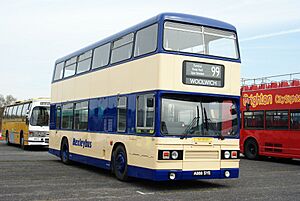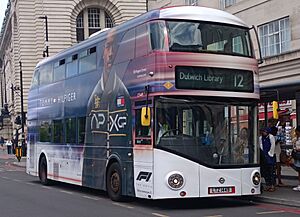London Central facts for kids
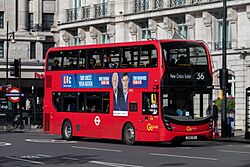
Alexander Dennis Enviro400H MMC on route 36 at Marble Arch in September 2022
|
|
| Parent | Go-Ahead London |
|---|---|
| Founded | 1 April 1989 |
| Headquarters | Merton |
| Service area | South London |
| Service type | Bus services |
| Depot(s) | 5 |
| Web site | www.goaheadlondon.com |
The London Central Bus Company is a bus company that runs many buses in London. It is part of a bigger company called Go-Ahead London. London Central mainly operates bus services in South London. They do this under a special agreement with Transport for London, which manages most of London's public transport.
History of London Central Buses
In April 1989, the main London Buses company was split into 11 smaller parts. One of these new companies was the London Central Bus Company.
Later, in September 1994, London Central was sold to the Go-Ahead Group. This was part of a plan to make London's bus services more private.
In August 2008, all the London bus companies owned by the Go-Ahead Group started using the name Go-Ahead London. Even though they used this new name, the individual company names, like London Central, still appeared on most buses. In 2017, London Central became part of the London General license, but its name stayed on the company logos.
Bus Garages of London Central
London Central operates from five different bus garages. These garages are like big parking lots and maintenance centers for the buses.
Bexleyheath Garage (BX)
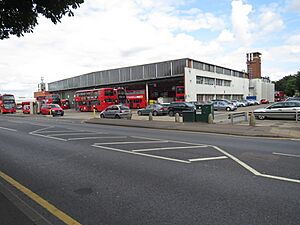
Bexleyheath garage runs many bus routes, including 89, 99, 132, 269, 401, 486, 601, B11, B12, B13, and B16. It also temporarily helps with the Fastrack bus network in the Thames Gateway area.
Bexleyheath Garage: A Look Back
This garage was first built in 1935 for trolleybuses. These were buses that got their power from overhead electric lines. Bexleyheath was the only new garage built just for trolleybuses.
Later, the trolleybuses were replaced by regular motorbuses. In 1986, the Bexleyheath garage closed for a while because fewer buses were needed. However, it reopened in 1988 under a new name, Bexleybus. This company tried to run bus services at a lower cost.
Bexleybus had a mix of different buses. But there were problems with maintenance and staff, which led to delays and breakdowns. Because of these issues, London Central took over the Bexleyheath garage and its routes in January 1991. The Bexleybus name was then stopped.
In recent years, the garage has been very busy, sometimes parking up to 139 buses. Bexleyheath also has a special system called iBus, which helps control bus routes for several garages.
In 2022, Bexleyheath became the first bus garage in London to use 'opportunity charging' for electric buses. This means buses can charge quickly while they are waiting at the end of their route. This system was introduced for route 132.
Since November 2024, Bexleyheath garage has also been temporarily housing the electric buses for the Fastrack network. These buses will move to a new garage in Dartford once it is finished.
Camberwell Garage (Q)
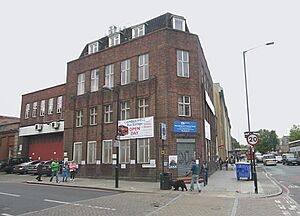
Camberwell garage operates routes 1, 12, 35, 40, 42, 100, 108D, 176, 185, 355, 360, 484, N1, and N15 (for extra services).
Camberwell Garage: Its Past
Camberwell garage first opened in June 1914. However, it was used by the army during World War I and did not become a bus garage until 1919. During World War II, the garage was bombed twice, damaging and destroying some buses.
In the early 1950s, Camberwell garage was updated. New workshops and parking areas were added. This allowed Camberwell to handle major repairs for its own buses and those from another garage.
When London's bus operations were divided in 1989, Camberwell was chosen as the main office for the London Central Bus Company. Between 1992 and 1993, new buses were delivered to Camberwell to replace older ones on route 3. These were the last new buses delivered before the bus services became private.
When the Go-Ahead Group bought London General in 1996, London Central's main office moved away from Camberwell. The old office building was later refurbished in 2001 and became Go-Ahead's training center for new bus drivers. It was updated again in 2019 to train over 1,000 drivers each year.
Today, Camberwell garage is one of the largest bus garages in the United Kingdom. It can hold 242 buses and employs 650 drivers. In 2015 and 2016, new New Routemaster buses were introduced at Camberwell for routes 12 and 68. In 2021, 42 charging points were installed for new electric buses on routes 100, 360, and 484.
Morden Wharf Garage (MG)
Morden Wharf garage operates routes 51, 178, 188, 225, 244, 286, 291, 386, 469, 624, 625, and 658.
Morden Wharf Garage: How it Started
Morden Wharf garage began operating on July 29, 2017. It is located on the Greenwich Peninsula, on the site of an old sugar factory. The garage officially opened on March 12, 2018. It can hold 125 buses and has 310 drivers. When it first opened, it ran routes 108, 129, 180, 188, 225, 286, and N1.
New Cross Garage (NX)
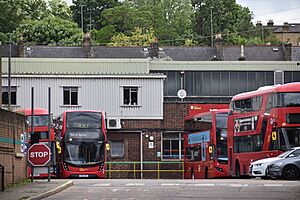
As of February 2025, New Cross garage operates routes 21, 36, 108, 171, 172, 321, 343, 436, 453, N21, N89, N136, N171, N343, and P4.
New Cross Garage: Its Story
New Cross garage is said to be the largest bus garage in London, with space for over 300 buses. It first opened in 1906 as a tram depot. In 1952, after the trams were removed, it was changed into a bus garage.
The number of buses at New Cross has changed over the years. It has never been completely full because other garages are nearby. However, it has often been used to store extra buses.
New Cross garage was also home to two special bus services. In 1972, it ran a sightseeing service called route 100. This service was brought back in 1977 for the Silver Jubilee of Queen Elizabeth II. In 2000, a special shuttle service was launched for the Millennium Dome, using a fleet of 17 buses.
On February 18, 1996, a London Central bus from New Cross garage was destroyed when a bomb went off on its lower deck. This happened while the bus was driving along Aldwych. Several people were injured, including the driver, who became permanently deaf.
In February 2003, New Cross garage started using 30 articulated buses (buses that bend in the middle) on route 436. These longer buses were later replaced by regular double-decker buses in November 2011. In January 2005, New Cross garage stopped using its last AEC Routemaster buses on route 36.
Peckham Garage (PM)
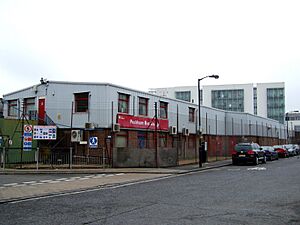
Peckham garage operates routes 37, 78, 197, and P12.
Peckham Garage: A Brief History
The original Peckham bus garage opened in 1951 but closed in 1994. London Central then took over a different building and opened a new Peckham bus garage. This new garage could hold 75 buses.
In January 2000, Peckham garage was the first in London to use new low-floor double-decker buses made by Volvo on route 63.
Peckham garage won the "Bus Garage of the Year" award in 2004. However, the next year, it lost almost half of its bus routes, including routes 381 and P13.
London Central Bus Fleet
As of December 2019, London Central needed 676 buses to run all its services during busy times.



